The Pros & Cons of Static Stretches
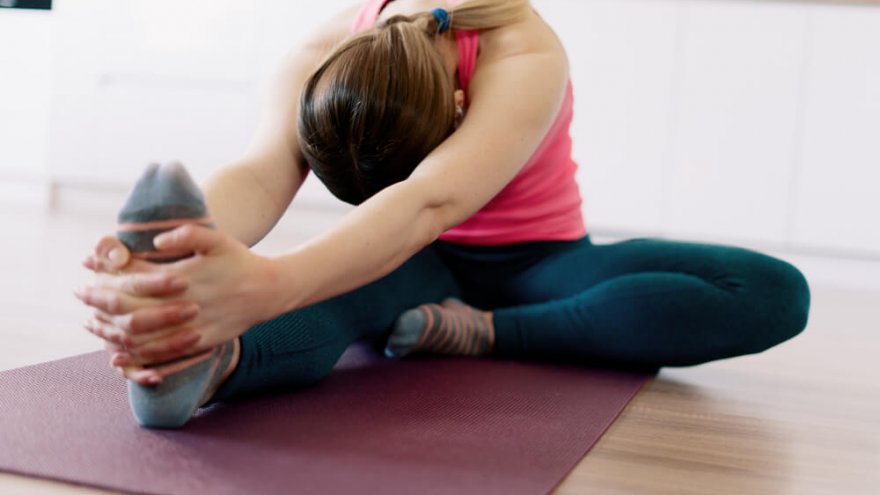
The topic of stretching has become a confusing one for runners. Why? Because most of us grew up being told to warm-up stretch before a run, or else we risk injury. But recent research has shown the opposite—doing static stretches, the kind where you hold poses for 15 seconds or longer—can actually do more harm than good.
Therefore, it is now recommended that runners DO NOT perform static stretches before they run.
In this article, we will look at the science-backed reasons for why you should not do static stretches before you run and if you should do static stretches after your run.
We will also review 7 static stretches recommended for runners as part of a cool-down.
So, let’s go.
What are static exercises?
A static exercise or static stretch means holding a stretch position for at least 15. The main purpose is to increase the flexibility of specific muscle groups and tissues. They differ from dynamic stretches, which are controlled movements aimed at increasing the range of motion.
How long is a static stretch?
A static stretch lasts for at least 15 seconds and can go up to a minute or longer, especially if you are performing a yoga sequence or repetitions.
What are the pros and cons of static stretches?
The primary beneift of static stretches is that they increase flexibility which is great for athletes such as gymnasts or dancers.
However, this pro becomes a con for runners. Runners want mobility (increased range of motion), not flexibility.
Think of runners’ muscles like springs. They compress when the foot hits the ground and then spring back, expending a ton of energy to propel us forward. The tighter the spring, the more powerful the recoil. If you stretch the spring, you lose the strength of the recoil.
Muscles that are overly stretched result in more ground contact of the foot and slower turnover of the legs—not what runners want!
Also, where many think static stretching before running can help prevent injuries and improve recovery, it may actually increase the risk of injury, and there is no evidence it decreases muscle soreness.
Is stretching bad for runners?
Yes, static stretching—especially before a run—is bad for runners in most cases.
Performing this type of stretching before running has been found to decrease running economy and performance by many studies. Specifically, research has found that static stretching before exercise reduced performance by 3.7 percent. Also, longer static stretches had a greater negative impact than shorter ones.
A 2009 study in the Journal of Strength and Conditioning Research found runners who did better at sit-and-reach tests had a lower running economy (the amount of oxygen your body uses to run at a certain pace).
The main reason is again tied to the spring analogy—the looser the spring, the slower the recoil.
On the other hand, dynamic stretches have been found to increase VO2 max in runners and prevent injury. Dynamic stretches are great to do before a run and include moves like hurdles, leg swings, and scorpions.
Should you do static stretches before or after a run?
Runners should not do static stretches before a run, but they can do static stretches after exercise if they enjoy it.
There is no scientific evidence that suggests static stretching after a run as a part of a cool-down will decrease your performance—as long as you don’t overdo it.
Some runners may find that stretching makes them feel less stiff after a run. It may be relaxing and help aid a cool-down. So, if you are injury-free and enjoy a static stretching routine, by all means, do it. (Alternatively, perform static stretches if directed by a healthcare professional to help treat an injury.)
If you are looking to increase mobility and decrease muscle soreness, aim to do a mobility routine 9watch video below) and dynamic stretches before your run and foam roll after your run.
7 best static stretches for runners
Here are some examples of static stretches for runners to be done after your run. Hold each pose for about 15 seconds as you breathe deeply.
Do not do these stretches if they extend past your range of motion or are painful!
1. Downward Dog
Start in a plank position with your left and right-hand shoulder-width apart and your fingers spread wide. Press your hands into the ground and begin to lift your hips up in the air, keeping your legs straight. Gently lift each foot in a walking motion as you “walk the dog.”
Feel the stretch in the backs of your legs in the hamstrings and calves.
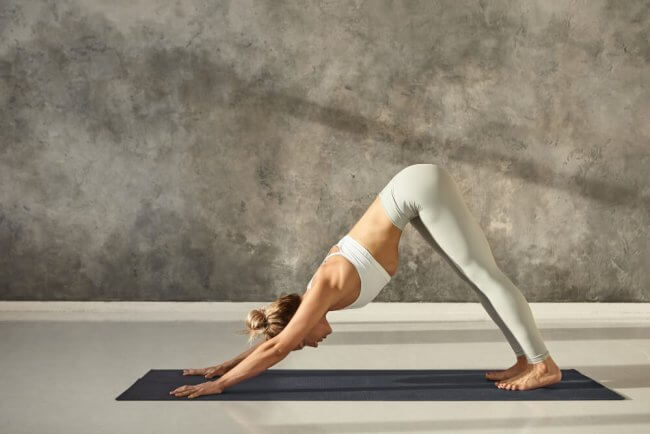
2. Pigeon Pose
Begin in a downward-facing dog. Swing your right leg up in front of your body. Lay it flat on the ground in front of your body with a bent knee so that your shin is parallel to the front of your tummy (or yoga mat). Flex your foot.
Meanwhile, keep your left leg straight behind you as you do this.
Now, slowly lower your bottom to the ground as low as you can. Sit up straight.
If you want a more intense stretch, lay your arms and head on the ground forward and then to the right and left sides. Feel the acute effects of the stretch in your hamstrings, groin, and torso.
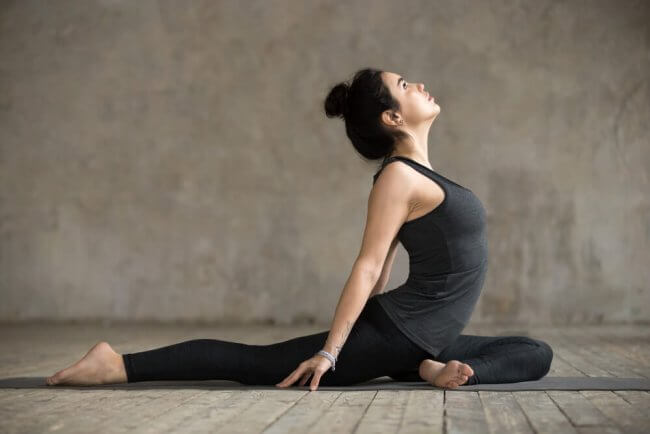
3. Quad pull stretch
You can bend the straight leg from the upright pigeon pose and grab your foot, gently releasing your quad. Support your body with your other arm in front of you.
Or, if this is not comfortable, you can do a standing quad pull stretch where you grab your foot while standing on one leg and pull it toward your glutes. Then switch legs.
This stretches your quad.
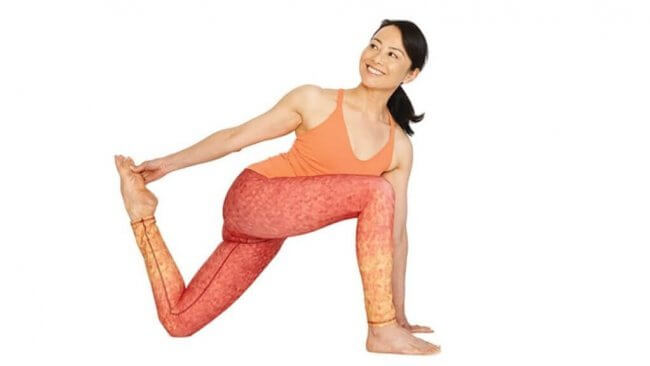
4. Runners Lunge
Start in a plank position with your right and left hand below your shoulders. Step one foot forward next to the pinky of the same side hand. Let your body relax through your hips and sink towards the ground. Hold for about 15 seconds and then switch sides. Feel the stretch in your groin.
If this is too intense, you can do a standing lunge where you do not sink low to the ground. Instead, start in a lunge position and drive your hips forward. Raise your arms overhead. Reach from side to side to stretch your sides along with your hips, thighs, and groin.
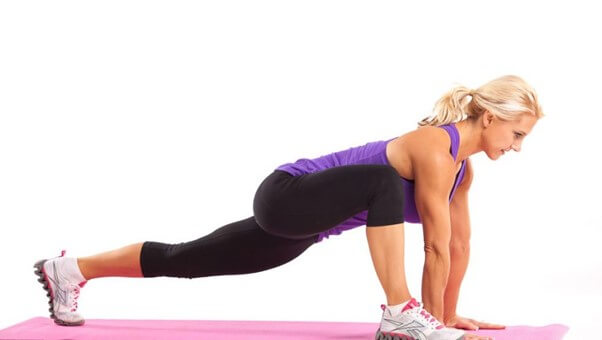
5. Iron Cross
Lie on your back with your arms wide and legs together, forming a “T.” Slowly kick one leg over your body towards the opposite hand. Hold for about 15 seconds. Switch and do the other side. Feel the stretch predominantly in your glutes and hamstrings.
When done, you can pull the right knee to your chest, then the left knee, and then both for an additional stretch in your groin.
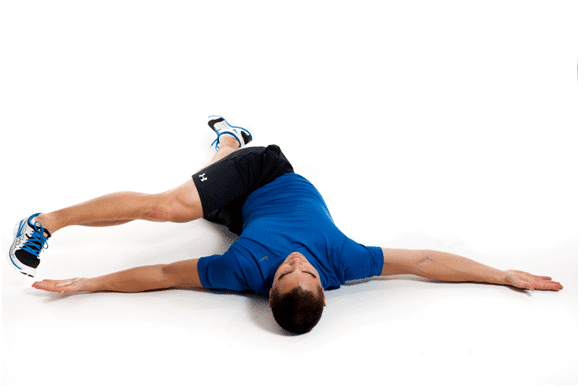
6. Child’s pose
Kneel and lean forward, keeping your glutes on your heels. Rest your forehead on the floor with your arms stretched straight in front of you. Hold here and then move your arms to one side and hold. Then move to the other side and hold.
Feel the stretch in your groin, hips, back, and sides.
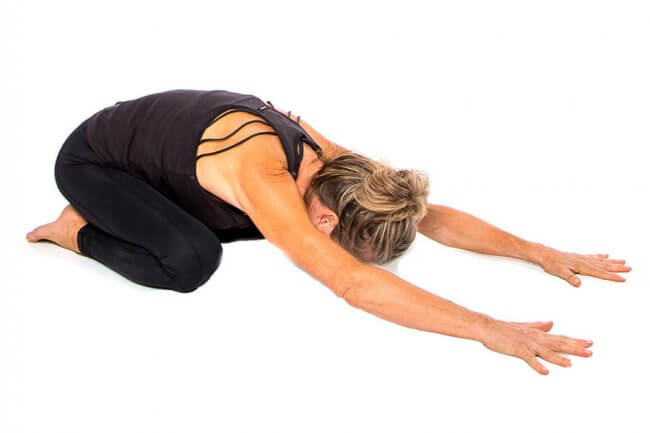
7. Legs up on Wall
This is one of the simplest stretches you can do after a run. Simply lie down and prop your legs up on a wall. This helps drain fluids collecting in your legs after a hard run while also performing a great hamstring stretch. This pose is one of the most popular among runners for recovery.
If you don’t have time to stretch after your run, don’t worry. It’s a matter of personal preference rather than a proven performance booster.
Latest Articles
 Is Running on a Treadmill Easier Than Running Outside?Runners have their own preferences, whether it is treadmill running, running outside on the road, or exploring trails. So...
Is Running on a Treadmill Easier Than Running Outside?Runners have their own preferences, whether it is treadmill running, running outside on the road, or exploring trails. So... Is It OK to Use Trail Running Shoes on the Road?While trail running shoes can be used on roads, especially in situations where a runner encounters mixed terrains or pref...
Is It OK to Use Trail Running Shoes on the Road?While trail running shoes can be used on roads, especially in situations where a runner encounters mixed terrains or pref... How to Fix Sore Quads After Running?Rest, ice, gentle stretching, and over-the-counter pain relievers can help soothe sore quads after running. Also, ensure ...
How to Fix Sore Quads After Running?Rest, ice, gentle stretching, and over-the-counter pain relievers can help soothe sore quads after running. Also, ensure ... 10 Fruits With The Most Electrolytes to Replace Sports DrinksThese fruits are high in electrolytes such as potassium, magnesium, and calcium, essential for hydration, muscle function...
10 Fruits With The Most Electrolytes to Replace Sports DrinksThese fruits are high in electrolytes such as potassium, magnesium, and calcium, essential for hydration, muscle function...

